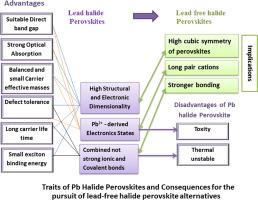Lead-free halide double perovskites for sustainable environmental applications
IF 3.8
Q2 CHEMISTRY, PHYSICAL
引用次数: 0
Abstract
The development of renewable energy sources has become a crucial objective in today's world due to increasing environmental concerns and the depletion of fossil fuels. Solar energy has emerged as a promising alternative. In recent years, there has been a significant focus on perovskite solar cells due to their remarkable power conversion efficiencies and their ability to be produced in a cost-effective manner. These cells have attracted considerable attention from researchers and industry professionals alike. However, traditional perovskite materials often contain toxic lead, raising concerns about their environmental impact and long-term sustainability. This article highlights the environmental concerns associated with lead-based perovskite materials and explores the advantages, challenges, and potential of lead-free halide double perovskites as sustainable alternatives for achieving an enlightening and sustainable future in the field of photovoltaics. Lead-free halide perovskites have been an area of active research in the field of nanotechnology and material science due to their potential for various applications. We provide an overview of perovskite solar cells as a promising technology, discussing their material properties and device performance. Furthermore, we present a comparative analysis between lead-based and lead-free perovskites, emphasizing the challenges and future perspectives associated with the development and implementation of lead-free alternatives. Through this analysis, we aim to shed light on the potential of lead-free halide double perovskites and inspire further research in the quest for environmentally friendly materials for solar energy applications.

用于可持续环境应用的无铅卤化物双包晶石
由于环境问题日益严重和化石燃料日渐枯竭,开发可再生能源已成为当今世界的一个重要目标。太阳能已成为一种前景广阔的替代能源。近年来,包晶体太阳能电池因其卓越的功率转换效率和低成本生产的能力而备受关注。这些电池吸引了研究人员和业界专业人士的极大关注。然而,传统的过氧化物晶体材料通常含有有毒的铅,引起了人们对其环境影响和长期可持续性的担忧。本文重点介绍了与铅基过氧化物材料相关的环境问题,并探讨了无铅卤化物双过氧化物作为可持续替代品的优势、挑战和潜力,以期在光伏领域实现一个富有启发性和可持续发展的未来。无铅卤化物包光体具有各种应用潜力,一直是纳米技术和材料科学领域的一个活跃研究领域。我们概述了包光体太阳能电池这一前景广阔的技术,讨论了其材料特性和设备性能。此外,我们还对铅基和无铅包晶石进行了比较分析,强调了与开发和实施无铅替代品相关的挑战和未来前景。通过这一分析,我们旨在阐明无铅卤化物双包晶石的潜力,并激励人们进一步研究太阳能应用中的环保材料。
本文章由计算机程序翻译,如有差异,请以英文原文为准。
求助全文
约1分钟内获得全文
求助全文
来源期刊

Chemical Physics Impact
Materials Science-Materials Science (miscellaneous)
CiteScore
2.60
自引率
0.00%
发文量
65
审稿时长
46 days
 求助内容:
求助内容: 应助结果提醒方式:
应助结果提醒方式:


